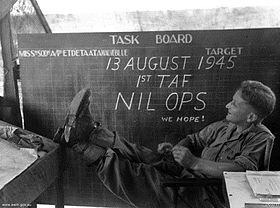| Australian First Tactical Air Force | |
|---|---|
 No. 1 TAF Headquarters following the Japanese surrender; one further strike was flown after this picture was taken. | |
| Active | 1944–46 |
| Country | Australia |
| Branch | Royal Australian Air Force |
| Role | Fighter; ground attack |
| Size | Three–five combat wings |
| Engagements | World War II |
| Commanders | |
| Notable commanders | Harry Cobby (1944–45) Frederick Scherger (1945) Charles Read (1945–46) |
| Aircraft flown | |
| Attack | Beaufighter |
| Bomber | B-24 Liberator |
| Fighter | P-40 Kittyhawk; Spitfire |
The Australian First Tactical Air Force (No. 1 TAF) was formed on 25 October 1944 by the Royal Australian Air Force (RAAF). Its purpose was to provide a mobile force of fighter and ground attack aircraft that could support Allied army and naval units fighting the Empire of Japan in the South West Pacific Area. One of several Allied tactical air forces formed during World War II, it evolved from the RAAF's No. 10 Operational Group, established a year earlier. Following action in the assaults on Aitape and Noemfoor, the group was renamed the First Tactical Air Force to better reflect its size and role. It was beset with morale and leadership issues in early 1945, but recovered to take part in the battles of Tarakan, North Borneo, and Balikpapan. Reaching its peak strength of over 25,000 personnel in July 1945, No. 1 TAF's squadrons operated such aircraft as the P-40 Kittyhawk, Supermarine Spitfire, Bristol Beaufighter, and B-24 Liberator. The formation remained active following the end of hostilities in the Pacific until it was disbanded on 24 July 1946.